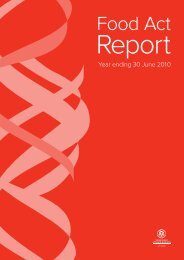Public Health and Communicable Diseases - SA Health - SA.Gov.au
Public Health and Communicable Diseases - SA Health - SA.Gov.au
Public Health and Communicable Diseases - SA Health - SA.Gov.au
You also want an ePaper? Increase the reach of your titles
YUMPU automatically turns print PDFs into web optimized ePapers that Google loves.
cancer among aboriginal women. This represents morethan nine times the death rate of non-aboriginal women(3.0 per 100, 000 women). 11In some countries the incidence of cervical cancerappears to be increasing due to recent changes in risktaking behaviour in young women. 13 There was a 60%increase in incidence of cervical cancer in Finl<strong>and</strong> inthe 1990s in young women. Over the same period oftime the number of lifetime sex partners significantlyincreased <strong>and</strong> the age at first intercourse decreased. 13Thus increasing exposure to HPV <strong>and</strong> other sexuallytransmitted infections is likely to explain the recentincrease in the incidence of cervical cancer observed inFinl<strong>and</strong> in young women.Population studies in the 1980s <strong>and</strong> 1990s in variouscountries detected an association between humanpapilloma viruses (HPV) <strong>and</strong> cervical cancer. 14 Cervicalinfection with HPV is extremely common compared tothe incidence of cervical cancer. 15 However, particulartypes of HPV have a strong association with persistent14, 16-18infection <strong>and</strong> a high incidence of cervical cancer.Human Papilloma Virus as a c<strong>au</strong>se of Cervical CancerThe association of cervical cancer <strong>and</strong> infectionwith a high-risk HPV type is supported by strongepidemiological evidence <strong>and</strong> by the detection ofHPV DNA in up to 99.7% of cervical cancers from allgeographic areas. 19 There are over 40 types of HPV,with 14 of these considered to be oncogenic. HPV16 isthe most prevalent high-risk HPV type <strong>and</strong> is presentin approximately 50% of cervical tumor specimensworldwide. HPV18 is the second most prevalent type<strong>and</strong> is associated with approximately 16% of cervicalcancers, with the remaining tumors containing DNAfrom other high-risk types such as HPV45, 31 <strong>and</strong> 33. 20The persistence of HPV in the genital tract is a riskfactor for development of cervical cancer. 16-18Approximately 470,000 new cases of cervical cancerare diagnosed each year, <strong>and</strong> nearly 200,000 deathsare attributable to the disease. 21-23 Consequently, thesocial <strong>and</strong> economic costs of HPV-induced diseasesof the genital tract are enormous, <strong>and</strong> development ofprophylactic vaccines has been an important initiative.Human Papilloma Virus VaccineVaccines against the high-risk types HPV-16 <strong>and</strong> HPV-18 have been shown to be safe <strong>and</strong> immunogenicin previous trials, <strong>and</strong> have prevented incident <strong>and</strong>persistent HPV-16/18 infection. The HPV vaccine isan inactivated virus vaccine which is not capableof replication or transfer of the virus to others. Twovaccines have been developed that are likely to beavailable in the next 12 months. Merck <strong>and</strong> Co. havedeveloped a quadrivalent vaccine, Gardasil whichcontains HPV 16, 18 (oncogenic types) <strong>and</strong> HPV 6<strong>and</strong> 11, benign types that are associated with genitalwarts. A bivalent vaccine, Cerverix has been developedby GSK which contains the leading oncogenic types,16 <strong>and</strong> 18. In Phase II <strong>and</strong> III studies, HPV vaccineshave been shown to be safe <strong>and</strong> 100% effective inpreventing persistent HPV infection. Recent publishedresults from a long term follow-up study of Cerverix,indicates long term (up to 4.5 years) protection againstpersistent infection <strong>and</strong> cervical intraepithelial neoplasia(CIN) changes with evidence of cross protection againstother oncogenic serotypes not included in the vaccine,including serotype 45. 24Pre-teen <strong>and</strong> young adolescent women will be animportant target population for vaccination, since itwill be important to protect prior to onset of sexualactivity <strong>and</strong> exposure to oncogenic HPVs. For HPVvaccine program to be effective, high coverage ratesespecially in high risk groups will need to be achieved.Linkages with other health care systems, improvedadult health services <strong>and</strong> education about the benefits<strong>and</strong> availability of the HPV vaccine will be vital to theachievement of high levels of coverage. Implementationissues including provision of <strong>Gov</strong>ernment funding,decisions on whether both males <strong>and</strong> females willreceive the vaccine <strong>and</strong> the target age group are yet tobe determined.The future challenge for these new vaccines will beto develop innovative funding strategies to ensureadequate vaccine delivery to populations with thehighest burden of disease.References1. Global Alliance For Vaccines <strong>and</strong> Immunisation (GAVI).Fact sheet no. 169, March 2001.2. Parashar U, Hummelman E, Bresee J, Miller M et al.Global illness <strong>and</strong> deaths c<strong>au</strong>sed by rotavirus diseasein children. Emerg infect Dis. 2003;9:565-72.3. Bresee J, Glass R, Ivanoff B, Gentsch JR. Currentstatus <strong>and</strong> future priorities for rotavirus vaccinedevelopment, evaluation <strong>and</strong> implementation indeveloping countries. Vaccine. 1999;17(18):2207-22.4. Galati J, Harsley S, Richmond P, Carlin J. <strong>Health</strong>economics <strong>and</strong> hospitalization data for RV infection.(Accepted to Aust N Z J <strong>Public</strong> <strong>Health</strong> subsequent tomanuscript amendment).5. Bonhoeffer J, Heath P. Update on new vaccines<strong>and</strong> immunisation strategies. Current Paediatrics.2006;16:1-7.6. Simonsen L, Viboud C, Elixh<strong>au</strong>ser A, Taylor R. More onRotaShield <strong>and</strong> intussusception: the role of age at thetime of vaccination. J Infect Dis. 2005;192(Suppl. 1):S36-43.7. Vesikari T, Matson D, Dennehy P, Van Damme P. Safety<strong>and</strong> Efficacy of a Pentavalent Human – Bovine (WC3)Reassortant Rotavirus Vaccine. N Engl J Med.2006;354:23-33.8. Ruiz-Palacios G, Pérez-Schael I, Raúl Velázquez F,Abate H et al. Safety <strong>and</strong> Efficacy of an AttenuatedVaccine against Severe Rotavirus Gastroenteritis. NEngl J Med. 2006;354:11-22.9. Ponten J, Adami H,Bergstrom R,Dillner J, FribergL, Gustafsson l, Miller A, parkin D, Sparen P,Trichopoulos D. Strategies for global control ofcervical cancer. Int J Cancer. 1995;60:1-26.24
















